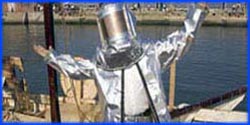


Premier Date: January 30, 2016
busted
In the workshop, Jamie constructed several rough car models by welding together steel cans and piping. These models more accurately reflected the scaled-down thickness of actual body panels than commercial model cars. At a bomb range, Jamie and Adam placed a model on the ground, sandwiched between two steel plates, with a layer of “detasheet” explosive above the top plate to drive it downward. The explosion crushed the model to a height of approximately 1 inch (2.5 cm), or 1/5 of its original height. Further testing with different configurations of plates and explosives often tore the models to pieces. A repeat of the first test with 50% more explosive gave the best result, so this configuration was used in the full-scale test.
Next, a real car was placed on a steel plate, with a second steel plate suspended directly above it. This plate weighed 7,000 pounds (3,200 kg) and was loaded with 1,000 pounds (450 kg) of ANFO. The resulting explosion effectively vaporized the car and threw pieces of the steel gantry 500 feet (150 m) into the air. Adam and Jamie discovered that the blast had punched through the upper plate, generating shrapnel that destroyed the car. They called the myth busted, with Jamie commenting that a steel plate thick enough to withstand the blast would be heavy enough to crush the car simply by being dropped on it.
confirmed
Adam and Jamie found that a vacuum cleaner with a standard attachment could only lift a 5-pound (2.3 kg) weight, but that its lifting power increased linearly with the cross-sectional area of the attachment. Adam built a suction cup 8 inches (20 cm) in diameter and they used it to easily lift a 50-pound (23 kg) weight. Based on this success, they built 40 such cups, all connected to a single vacuum via a manifold, and hung them from a steel frame that would be lifted by a crane.
On Treasure Island, the suction cups were placed on the hood, roof, and trunk of a 2,800-pound (1,300 kg) car. The first series of lifts looked promising but failed when excessive buckling of the hood caused some of the cups to pop loose. After they replaced the hood with a flat piece of sheet steel to eliminate the buckling, they were able to lift the car only 1 inch (2.5 cm) off the ground before it fell.
Back in the shop, they decided to replace the suction cups with three large plywood boxes, each one contoured to match the car’s surface and fitted with a rubber gasket for a tight seal. The three boxes had a combined area of 4,000 square inches (2.6 m2) and vacuum gauges recorded a vacuum pressure of 6 inches of mercury (20 kPa) for each box when the vacuum cleaner was running. Using this method, the car remained attached while being lifted to the crane’s maximum height, confirming the myth. Adam and Jamie then shut off the vacuum and the car crashed to the ground.
Previous: Episode 240: Cooking Chaos